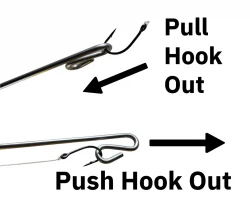Hooking a fish is one thing, unhooking a fish is another. Sharp hooks are designed to penetrate hard cartilage in a fish’s mouth. This nerve free material is like your fingernail.
If you plan to kill and eat the fish, smack it in the head and kill it. Now remove the hook and toss it on the ice for a fresh fish dinner. If you plan to Catch and Release a fish, be prepared, and learn the skills needed to do this correctly.

The best way to unhook a fish needs to be a small and minimally invasive tool. Surgical forceps work well but will also damage the lighter fishing lines. My favorite forceps are 7 inches long with a bent end. The bend allows me to get into the smaller places without damage.
Here are some thoughts on Hooking Ins and Outs!
A sharp hook penetrates and dehooks easier than a dull hook. The hole size of a barbed hook will be slightly larger and easier to angle and remove.
Barbs help keep a fish on the line but do not cause damage than a barbless hook. No data supports that Barbs kill more fish than barbless hooks. I did the largest study on this topic involving 400 trout. What killed the fish was not the barbs.
Mortality comes down to bleeding. If the gills are damaged and bleeding, the fish is done. Sharp hooks make a better and less bloody incision.
Single hooks catch more fish than trebles and are easier to remove. Treble hooks are perfect for snagging but an oversized, sharp, single hook, with a larger eye, will make for more hook ups and is easier to remove.
Circle Hooks tend to hook fish in the mouth rather than in the guts. They are a little harder to remove due to their bent point on the hook.
Even with the best and most practiced Catch and Release techniques, a fish can only be caught and released a few times. Lactic acid, net scars, loss of fish mucous, loss of an eyeball, damage to the air bladder are also deadly to hooked fish.
Other things will damage the fish in a battle. Fish scrape on the bottom and debris. They strain and stress during the battle. A longer battle means it takes longer to gain their appetite to feed again. The net, dropping fish in dirt/gravel/grass, and other abuse will kill the fish slowly and surely.
Cellphones kill more fish than any other Catch and Release technique. It is not necessary to take cellphone selfies of every fish you catch. Seconds matter when a fish is out of the water, getting squeezed, and abused for a picture.
The best tools for hook removal depend on the fish species. Small, mouthed fish require smaller forceps or dehookers. Large, toothed fish require a longer stronger tool to push and pull the hook free. You will probably not want to shove your fat fingers down the throat of a toothed fish. Needle nosed pliers, or extended hook removing tools can be a better choice when dealing with heavy mouthed fish. Many of us were first taught to use a red plastic disgorger that was jammed down the fish’s throat and shoved the hook free.
One newer product that I have seen is called the “One and Only Fish Dehooking Tool.” You can check it out on YouTube videos. This straw like tool looks good for some fish species.
Fish are fragile. Jerking and yanking on the hooked fish is sure death. The bleeding, injured fish may swim away but will become food for the raptors and predators.
The worst-case scenario may mean that you need to cut the line. A forged hook will dissolve and rust in just a few days. Stainless steel hooks may get passed or stay in the fish.
Hook up and out simply, quickly, and carefully.
Montana Grant
